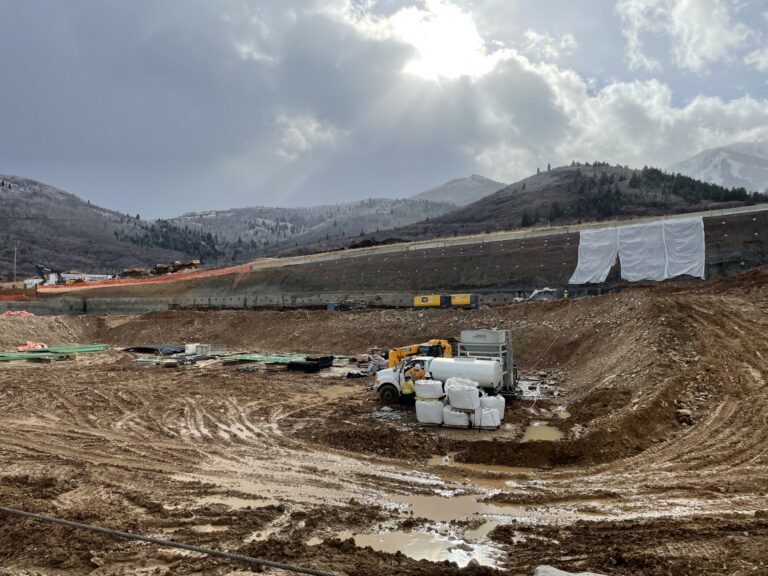
Rebecca Stone, principal at OZ Architecture, leads the Resorts + Hospitality practice, designing some of the most high-profile resorts and private retreats in the country, including the award-winning Lone Rock Retreat in Bailey, the Viceroy Snowmass in Aspen and Kindred in Keystone, Colorado, and Oasis at Death Valley in Death Valley, California. Mile High CRE spoke with Rebecca about her experience in and approach to designing mountain town resorts.
What are the key factors to consider, and opportunities and challenges when designing resorts for high alpine mountain sites?
What makes alpine environments appealing to visitors—snowy conditions, remote locations, steep but beautiful terrain—also makes for unique challenges for designers and contractors. Contending with access challenges, connecting utilities to the site, working within short building seasons and navigating often federally controlled land are important factors that impact building design and construction execution.
On a typical high-altitude construction site, crew and material access are via old logging roads or gondolas and even by helicopter. Crews can face literal barriers—like granite the size of cars—which must be blasted and cleared to set foundations. In terms of design, mountain sites can also have very little workable soil. We have sites where the foundations are literally holding up forty feet of the mountain or where underground water exists, and pumps are needed to ensure that water does not ‘float’ the building. These conditions are not typical and require significant planning and knowledge of design and construction techniques. As architects, we work closely with our engineers to get creative with the design, review unique soils early in the process, and often design with component parts that are more easily assembled on-site than traditional construction.
Connecting utilities is another major challenge when building in remote locations. This process can take years to properly organize; however, many areas where our developer clients are looking to put on-mountain amenities are better served by not having on-grid utilities at all. OZ recently completed an off-the-grid food and beverage concept for a client in Montana. The concept was made possible with innovative, sustainable approaches, including solar and wind power, recycling water, incinerating trash, capturing nutrient waste for fertilizer, biofuels and leech fields—all options that are more readily available and viable for on-mountain construction today than they were even five years ago. Creating closed-loop systems will allow resort on-mountain buildings to operate more efficiently, reducing equipment and resources going up the mountain and overall costs and environmental footprint.
The climate at high elevations also makes for a much shorter building season, which necessitates a highly efficient design and build process. The typical winter season has lift operations that run from mid-October to mid-April (at least that is the goal of most ski resorts!). That leaves the building team with just six months of the year to work on an on-mountain structure. During those summer months when crews can be building, they are often contending with scattered afternoon lightning storms. As a result, the phasing of a resort project can make all the difference in ensuring maximum usability (and profitability) for the resort throughout the construction process—particularly, if the process goes on for several summers.
Another consideration when designing in mountain environments is the navigation of added layers of approval on federally owned lands. The U.S. Forest Service owns a significant portion of land in the mountains. In Colorado, for example, about 65% of forests are under federal ownership. To build in these largely federally controlled environments, successful navigation of the approval process requires a strong understanding of requirements, the Forest Service design guidelines, the federal regulations and the primary elements and conditions that must be met by the design and construction team.
How do you balance the need to create an authentic, local experience for guests while still providing all the amenities and services they expect from a luxury resort?
To create unique destinations, resorts are reimagining and updating offerings with an emphasis on placemaking and preserving local character, while adding vibrancy and hotbeds through a mix of uses. For-sale residential, boutique-style hotels, elevated food and beverage offerings and place-based amenities are all essential considerations for the modern mixed-use ski base area. These developments are geared towards guests and locals and designed to be inviting hubs for social interaction. This shift to design for inclusion as opposed to strict exclusivity is enlivening base areas as developers and operators seek to provide opportunities to gather from morning coffee through late-night entertainment. Flexible spaces with shifting uses, and consideration of all generations and varied activity levels, are critical to supporting desired guest experiences.
What role does sustainability play in resort design for mountain towns, and what innovative solutions have you seen in this area?
The effects of climate change have the potential for a tremendous impact on the economic well-being of mountain resort communities. As a result, many resort operators have made major commitments to combatting global warming and environmental degradation, leading the way among outdoor recreation industries in taking immediate and measurable action. Operators are eager to share their journey, approach and values with visitors, engaging with firms like OZ Architecture to envision creative design solutions to meet ambitious climate goals. Our firm is increasingly seeing sustainable certification programs being embraced, from the more traditional LEED certification to newer programs like WELL, Green Globes and the Living Building Challenge. Certain sustainable design features are becoming the norm in mountain communities, from the incorporation of alternative energy sources such as geothermal, solar and wind power to make entire developments more self-sustaining, to the use of locally sourced, hyper-resilient materials to ensure buildings are protected against the elements for generations. By investing in high-performance systems and materials, we work with our clients to create a legacy that prioritizes long-term resilience and environmental stewardship.
How do you ensure that your resort design considers the needs and desires of the local community, and how do you work with them to create a project that benefits both visitors and residents?
As resort communities expand through enhancements to existing buildings and new developments, designing to maintain local character and sense of place is a key tenet for the OZ Resorts + Hospitality Practice Area. Designs that harmonize with existing architecture through an understanding of each town’s unique history and community continue to contribute to the texture and landscapes that make mountain communities special places to visit. We often involve local planners, who understand the community’s needs, as stakeholders in the early design and programming of mountain projects. Many of our resort clients are very open to partnerships or alignments with the community and ensuring that development meets broader goals and needs. This has helped ensure successful projects that are embraced and supported by locals.
As mountain communities evolve and grow, many now find themselves at a crucial juncture. Nearly all resort communities are facing a critical housing shortage for the workforce that keeps them running and are also in need of supportive infrastructure and municipal facilities such as fire stations, medical buildings and schools to keep them functioning. To thrive, these communities must employ a more holistic approach that supports the entire resort ecosystem, year-round.









